BUSINESS
The Rise of the Overlanders
Who Are They and What Are They Searching For?
By Mike Imlay
They say it started in South Africa and Australia, spread rapidly through South America, and now has gripped North America. We’re talking, of course, about the overlanding phenomenon, an outdoor addiction that many aftermarket companies have become keenly aware of—so much so that the SEMA Show added an Overland Experience feature dedicated to the trend in 2019. But who exactly are these overlanders? What do they seek, and how is the industry discovering opportunities in helping them find it?
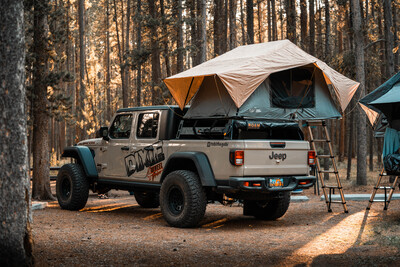
Pop-up tents on 4x4 rigs like this one built by Dixie 4 Wheel Drive have become a ubiquitous hallmark of overlanding. However, the growing overland phenomenon goes far beyond camping and trail riding.
The fact is, while closely associated with the truck and off-road segment, overlanding is evolving into its own market space embracing a dynamic consumer mix. However, defining the phenomenon isn’t so easy—perhaps because it’s largely a state of mind for true enthusiasts.
“They identify as campers, they identify as adventure travelers, they identify as off-roaders, they identify as explorers, so really there’s a lot of different ways they see themselves,” said Lindsay Hubley, managing partner for Lodestone Events LLC, which presents the popular Overland Expo event series. “Overlanding is really a self-sufficient vehicle or adventure mode of travel where it’s all about the journey. At its real core, overlanding is about exploration.”
That exploration has historically been accomplished through dedicated off-
roading vehicles ranging from Land Rovers to 4WD trucks and Jeeps, but even that is changing, said Andrew Funk, president of Cap-it International, which operates an expanding franchise of truck-and-adventure accessory outlets throughout Western Canada.
“What this market has brought to us is new manufacturers and better-quality products,” Funk said. “There are new ‘glamping’ and creature comforts that are nice while you’re out in the bush off-roading, but it has really become more mainstream to where you’re sometimes putting tents on really small SUVs—and cars, for that matter. It’s becoming so mainstream now that your average consumer is seriously looking into it as an option.”
As a result, manufacturers and retailers have had to think beyond traditional camping and off-roading paradigms to fully engage overlanding consumers. Overlanders tend to see the serendipity of expeditioning as their goal and enjoy immersing themselves in the environments and cultures they encounter. Some enthusiasts even ship their vehicles to other continents for more exotic treks.
“It’s camping, but it’s a lifestyle, so you need bigger tires and a lift kit to get into some of the places you want to go,” Funk explained. “The solar technology that’s now available means you can carry more electronics, so you’re bringing fridges along with you. Rooftop tents are obviously great, but then you’ll need lighting as we come into fall, so it’s more than just camping equipment. It’s more about the journey to get there than it is about just sitting at the destination.”
However one defines the phenomenon, its popularity shot up during the 2020 pandemic.
“COVID put a massive focus on the ‘staycation,’ at least up here in the Pacific Northwest and British Columbia,” Funk said. “Everybody’s going camping—and as the campsites closed down, people started going deeper into the backwoods.”
“I think it’s blowing up quite a lot, especially recently,” agreed Patrick Heiner, a sales spokesperson for Dixie 4 Wheel Drive, which operates off-roading shops in both St. George and Moab, Utah. “Obviously, everyone’s had a lot more free time on their hands this last year, so they’re getting out a little farther than they generally used to on just a weekend trip. Now it’s full weeklong trips and hundreds of miles.”
According to Dixie 4 Wheel Drive General Manager Tara Thompson, the company’s overlanding customer demographic reflects a variety of backgrounds and needs.
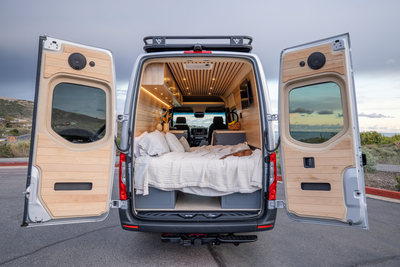
The “van life,” made possible by conversions like this one done by the Van Speed Shop, is an important offshoot of the overlanding market. It screams “California” and echoes the “bohemian travel” culture of the ‘60s and ‘70s.
“I would say it’s a very broad customer base, because you do have that ‘just overnight’ guy who wants an easy pop-up tent, and then you have the guy who’s building a whole van to live in and actually travel across the country for a year or two,” Thompson said. “But it tends to be a younger crowd, because most of our overlanders like to explore. They still want to get out and hike, and most of it’s getting them to those areas to do that, so they tend to be younger to mid-40s, [with] probably 50s being the oldest that we usually help in our stores.”
Thompson added that newcomers to overlanding may start with some typical off-roading mods such as wheel, tire and suspension upgrades and maybe a rooftop tent, but whatever they buy, their purchasing decisions are deliberate and well-researched.
“One of the best parts about our two locations is that we get people who actually use their vehicles,” she said. “It’s a lot more fun to do the builds for people who understand what they’re putting on and actually use it. We have true enthusiast-lifestyle customers who are primarily down-to-earth people. They’re into a lot of outdoor hobbies, so most of them are off-roaders, hunters, fishers—anything outdoors-related they usually have on their hobby lists.”
Of course, large consumer events always offer direct insights into markets, and Overland Expo has positioned itself as a primary event series for do-it-yourself adventure-travel enthusiasts. All the regional Expos offer a high degree of interaction through hundreds of session-hours of classes for four-wheelers and adventure motorcyclists, along with demonstrations, a film festival and a huge exhibitor-vendor contingent representing travel equipment, camping gear, bikes, vehicles and services.
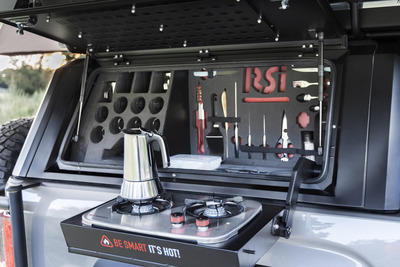
Headquartered in South Africa, SmartCap has found success in the North American market by offering truck caps and bed storage solutions—not to mention cooking and other gear—to consumers embracing a compact, adventuring lifestyle.
According to the Expo’s own market research, its demographics skew toward a solid base of high-earning professionals who travel frequently and spend the time and resources to learn the skills and acquire the equipment they need. Among age groups, 26% of the event’s audience falls between ages 25 to 44, and 28% between 45 to 54. By contrast, people aged 25 to 34 and 55 to 64 make up 15% and 20% of the Overland Expo audience, respectively.
Key activities enjoyed by these demographics include exploring (4%), photography and videography (5%), hunting and shooting (7%), fishing and fly fishing (15%), biking (22%) and hiking (26%).
“The interesting part about overlanding is that we’re seeing growth from all levels of the demographic spectrum, but what they’re buying is definitely trending differently,” Hubley said. “An older-demographic couple—probably higher up into their 50s and 60s—have more disposable income, so traditionally they’re looking at Sprinter Van conversions and some of the higher-end Unimog-type vehicles, Earth Roamers and so forth. Then the younger generation we’re seeing coming into the market is your Jeep Gladiator or Toyota 4Runner-type audience.”
Consequently, the overlanding phenomenon presents the automotive aftermarket with a vast array of crossover market opportunities, Hubley said. The emphasis with off-roading is often how one builds a vehicle to take on a trail, but overlanding is different, she explained.
“With a lot of [overlanders], the way they got into the sport was from the outdoor-recreation side,” Hubley observed. “They were maybe birdwatchers, mountain bikers or climbers interested in life off the grid during travel, so they sourced the off-road products needed to do that journey. What I would say to aftermarket manufacturers is that it’s not only a trend that’s here to stay but also developing an entirely new audience of buyers who maybe have never even thought about outfitting their vehicles for off-road travel.”
That means they’ll be turning to the aftermarket for solutions to tackling rough terrain, surviving and staying connected while off the grid for prolonged periods, and carrying and stowing gear for kayaking, backpacking, biking, cooking, sleeping and more. In fact, refrigerators, solar panels and generators, communications technologies and even showers are especially sought-after, both as freestanding purchases and as integrated parts of vehicle builds.
“It mostly depends on where they want to start,” Heiner said of consumers. “We have some who just want to start with the tents and basic weekend campout stuff. They don’t worry about suspensions and things like that. Some work the other way. They worry about off-road capability first and then start adding the overland accessories after they know that their vehicles are good and capable of getting them out farther.”
Retailers might also want to rethink how they brand their outlets and present products. This is a demographic that likes to visualize how products can enhance their odysseys. The opportunity to see, touch and experience products factors into purchase decisions, and spouses, family or friends can also influence choices.
“It’s a male-dominated industry, there’s no doubt about that,” Funk said. “But the style and the demographic that we’ve always been going after is based on the idea that a woman should be comfortable shopping at our store. It’s not a mechanic’s shop; it looks nice.”
He added that Cap-it underwent a rebranding in the early to mid-’00s that helped it better engage with the then-emerging overland sector, among other customers.
Given the sales opportunities, even OEMs are now tapping the aftermarket to develop accessory packages for overland-capable vehicles. A case in point is GMC’s Canyon AT4 Concept truck, which debuted at the recent Overland Expo Mountain West event held in late August 2021.
“We wanted to showcase the GMC Canyon with this concept and punctuate GMC’s commitment to premium, off-road capable vehicles. Consumer reaction to this concept’s design will help us further serve the growing market of buyers leading authentic outdoor lifestyles,” said Buick and GMC Global Vice President Duncan Aldred.
Among the build’s many features was a SmartCap EVOa truck cap. Headquartered in South Africa, SmartCap specializes in a broad range of truck bed products, that primarily center around their EVO range of truck caps and their system of accessories that seamlessly plug-and-play with the cap. As a part of that system, the company also offers a Kitchen-Bin that includes a camp-stove and other related outdoor-kitchen items.
According to SmartCap Vice President of Global Marketing Jason Ehrlich, “The EVOa can support more than 700 lbs. while delivering versatile storage and organization capabilities that overlanders look for when wanting to not just survive, but thrive in their outdoor adventures. Hunters, fishermen, tradesmen, photographers, people into overlanding—there are all sorts of ways people tend to use their trucks, and they’re taking our product and configuring a setup exactly as they need it,” said Ehrlich.
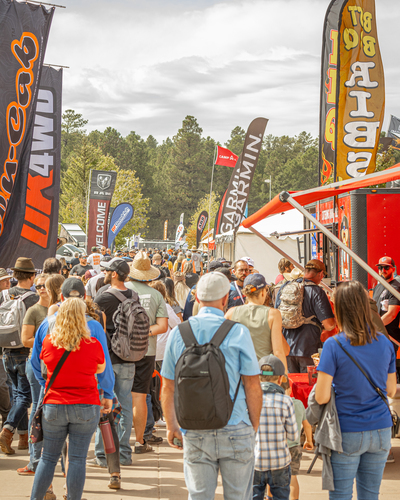
The Overland Expo has become a popular series of consumer-based events for adventure-travelers. Focusing on education, demonstrations, vendors and more, the Expo speaks to a wide-ranging market that has only grown since the recent pandemic.
Versatility is, in fact, a defining word for overlanders, since the way they chase their dreams can take on many distinct forms depending on geography and culture. A prime example can be found in Costa Mesa, California, where Van Speed Shop CEO Duran Morley is addressing another distinctive offshoot of the overland craze dubbed “the van life.” In the past several years, his shop has exploded doing high-end Mercedes-Benz Sprinter Van conversions. (The enterprise also operates The Van Mart, which specializes in affordable parts and accessories for van owners doing their own builds.)
“Maybe this is their exchange for a truck,” Morley said of his customers. “In Southern California, it’s become dad’s trade for a minivan. It’s a vehicle that can store things, bring the kids up from school, and go to the beach as a family getaway vehicle. We also have a lot of customers who use it during the week as a work truck that can fit ladders, construction gear and whatever. Then, on the weekend, they shift everything out, throw in a cabinet and a bed, and have a full-on conversion rig.”
For adventure travelers, the vans have become a popular alternative to the traditional 40-ft. RV. They boast kitchen setups, electronics and entertainment conveniences, along with space to spare for mountain bikes and snowboards.
“I want to give everybody the opportunity to explore and enjoy van life as much as I do,” Morley said.
He added that for him there are no “typical” customers. They could be young people in their 20s working nine-to-five jobs or making their way as YouTube influencers, or they could be thirtysomethings with families, or retirees looking to explore. He’s even built vans as less-expensive housing alternatives to college dorm rooms. The one distinction he sees is that truck-based overlanding customers tend to be individuals or couples, while his customer base tends toward bigger families with disposable income.
“We offer luxury conversions that are nice and definitely scream ‘California original lifestyle,’” he said.
If anything, Morley’s work underscores how wide-ranging overlanding can be, as well as the numerous ways every segment of the aftermarket—from manufacturers to retailers to builders—has rushed in to meet the expanding needs of a rapidly growing enthusiast base. But where will the phenomenon take the aftermarket as we turn the corner into 2022?
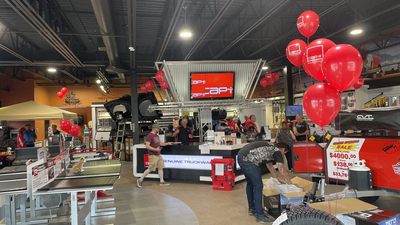
Cap-it International has long catered to overlanding customers, who tend toward experiential purchasing. They like to see, touch and imagine how products will work on their journeys, and listening to them is crucial to expanding retail sales.
“I think the industry has exploded,” Funk said. “I see a lot of small manufacturing shops—especially in the United States or North American-based—that have just grown out of nowhere in the last 12 months and are just doing phenomenal now. My complaint would be no different from the rest of the world—waiting for products to come out of China. The prices are going sky-high only because of freight and shortage of supply.
“The consumer will only put up with those price increases for so long. Everything will shift backward, and I think it’ll resettle them appropriately. But the encouraging thing is that I’m seeing more and more manufacturing coming back to North America. There are quality issues overseas, but not with the products we’ve been bringing in. We focus on the good-quality product, [and so] why not build local?”
In the end, Funk said, continued growth will depend as it always does on listening to the customer and accompanying them on their journey, wherever they may want to go.






